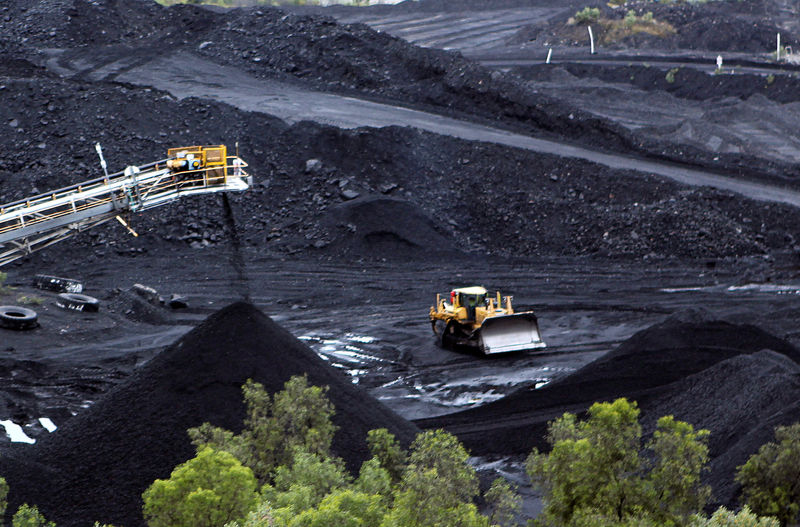(The opinions expressed here are those of the author, a columnist for Reuters.)
By Clyde Russell
LAUNCESTON, Australia, June 26 (Reuters) - Here's a question for the anti-coal lobby. If coal is dying, how come there is an increasingly heated bidding war going on for Rio Tinto (LON:RIO)'s coal mines in Australia?
Here's another question, this time for the pro-coal lobby. If coal still has a viable long-term future as an energy source, how come the world's biggest planned new mine is now hostage to whether the Australian government decides to loan it money?
Reconciling these two questions may seem like a challenge but both the battle for Rio Tinto's RIO.AX existing mines and the struggles of India's Adani ADEL.NS to build its Carmichael project neatly show where coal currently finds itself.
Rio's mines in the Hunter Valley north of Sydney are attractive to both Glencore GLEN.L and China's Yancoal YAL.AX because they are likely to be profitable for the remaining life of the pits, which is expected to be around 20 years.
The Rio mines already have all the necessary infrastructure, being connected by rail to the major export harbour of Newcastle, the world's largest coal export port.
They also have existing customers for the high quality thermal coal used to generate electricity, including utilities in Japan, which have preferred long-term supply agreements over the more volatile spot shipments that are more characteristic of deals to sell to major importers China and India.
In some ways the Rio mines up for sale are insulated from the downturn in global coal demand expected over the next 30 years, because they supply fuel to customers who are likely to be among the last to switch off coal-fired generators, assuming renewables do eventually succeed in killing off the polluting fuel.
Acquiring an existing asset is likely far more attractive to a company such as Glencore than developing new mines, with the associated capital costs and inevitable opposition from environmental groups.
Glencore raised its offer for Rio's Hunter Valley mines to $2.675 billion in cash on June 23, making its bid some $225 million more than Yancoal's proposal. said it would study the revised Glencore offer, having previously accepted the lower Yancoal bid on the grounds that it could be completed more quickly as it had regulatory approvals.
COAL MAY BE DYING, BUT IT'S GOING TO LINGER
It may seem incongruous to environmentalists that there is a bidding war for something that has been declared a dying industry, but there is still a medium-term future for coal, and Glencore and Yancoal are trying to profit from that.
The International Energy Agency (IEA) said in its medium-term coal market report in December that it still expects growth in coal demand up to 2021, albeit at a considerably slower rate.
The rise in coal demand is likely to be driven by India and Southeast Asia, according to the IEA, with top consumer China actually using less by 2021 than in 2015. IEA expects global coal demand to be 5.636 billion tonnes of coal equivalent in 2021, up from 5.4 billion in 2015, equating to an average annual growth rate of 0.6 percent, down from 2.5 percent over the decade to 2015.
Like all forecasts, the IEA's estimates can be undone by changing circumstances, and it does appear to be the case that renewable energy sources like solar and wind are making faster than initially expected inroads, especially in India.
It's this mounting uncertainty that is making it hard for Adani to get its planned 25-million tonne a year Carmichael mine in Queensland state to a stage where it can actually start construction.
While the Indian conglomerate has taken what it termed a final investment decision on the $4 billion mine, it's also likely that it won't go ahead unless support from Australia's federal government is forthcoming. Adani wants close to $1 billion in loans from the government in order to build some 400 kms (240 miles) of new rail track to link the mine to the planned export port.
Adani has already secured an undisclosed agreement with the Queensland state government that is believed to lower the burden of royalty payments, especially in the mine's early years of operation.
Even if the federal government does lend the money, the Adani mine appears to be on somewhat shaky ground, given that its intended export market of India has a government with a stated policy goal of cutting coal imports to zero.
While Australian governments have in the past assisted with infrastructure projects, the Adani mine was supposed to be proof that the private sector could pull off a major project with only supportive government regulation and not cash.
There is still a good chance that the federal government will pony up the cash for Adani, given the ruling Liberal/National coalition has several pro-coal lawmakers and would like the credit from the jobs that will come with building the mine.
But Carmichael may also be the last of its kind, given how prolonged and difficult its birth has been, with a well-funded environmental campaign against the mine and ongoing questions about its viability.
It's hard to see any commercial bank being willing to fund a massively costly coal project in the future, given both the uncertainty over long-term demand and the negative publicity that is sure to be generated.
But oddly enough, the travails of getting a new coal project off the ground probably makes the jostling over existing mines more likely, as companies seek to extract the last dollars available from coal's twilight.
(Editing by Richard Pullin)
